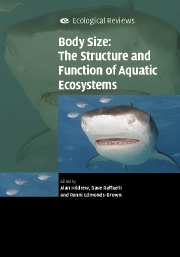Book contents
- Frontmatter
- Contents
- List of contributors
- Preface
- 1 The metabolic theory of ecology and the role of body size in marine and freshwater ecosystems
- 2 Body size and suspension feeding
- 3 Life histories and body size
- 4 Relationship between biomass turnover and body size for stream communities
- 5 Body size in streams: macroinvertebrate community size composition along natural and human-induced environmental gradients
- 6 Body size and predatory interactions in freshwaters: scaling from individuals to communities
- 7 Body size and trophic cascades in lakes
- 8 Body size and scale invariance: multifractals in invertebrate communities
- 9 Body size and biogeography
- 10 By wind, wings or water: body size, dispersal and range size in aquatic invertebrates
- 11 Body size and diversity in marine systems
- 12 Interplay between individual growth and population feedbacks shapes body-size distributions
- 13 The consequences of body size in model microbial ecosystems
- 14 Body size, exploitation and conservation of marine organisms
- 15 How body size mediates the role of animals in nutrient cycling in aquatic ecosystems
- 16 Body sizes in food chains of animal predators and parasites
- 17 Body size in aquatic ecology: important, but not the whole story
- Index
- References
Preface
Published online by Cambridge University Press: 02 December 2009
- Frontmatter
- Contents
- List of contributors
- Preface
- 1 The metabolic theory of ecology and the role of body size in marine and freshwater ecosystems
- 2 Body size and suspension feeding
- 3 Life histories and body size
- 4 Relationship between biomass turnover and body size for stream communities
- 5 Body size in streams: macroinvertebrate community size composition along natural and human-induced environmental gradients
- 6 Body size and predatory interactions in freshwaters: scaling from individuals to communities
- 7 Body size and trophic cascades in lakes
- 8 Body size and scale invariance: multifractals in invertebrate communities
- 9 Body size and biogeography
- 10 By wind, wings or water: body size, dispersal and range size in aquatic invertebrates
- 11 Body size and diversity in marine systems
- 12 Interplay between individual growth and population feedbacks shapes body-size distributions
- 13 The consequences of body size in model microbial ecosystems
- 14 Body size, exploitation and conservation of marine organisms
- 15 How body size mediates the role of animals in nutrient cycling in aquatic ecosystems
- 16 Body sizes in food chains of animal predators and parasites
- 17 Body size in aquatic ecology: important, but not the whole story
- Index
- References
Summary
More than ten years ago, two of us (AGH and DGR) were lucky enough to edit a previous symposium of the British Ecological Society (BES) – Aquatic Ecology: Scale, Pattern and Process (Giller, Hildrew & Raffaelli, 1994). In the Introduction to that volume, we pointed out that the BES had not devoted a single previous symposium to aquatic ecosystems. Evidently we did not change the culture, since the Body Size symposium held at the University of Hertfordshire in September 2005 was only the second! Aquatic Ecology: Scale, Pattern and Process had two objectives: (i) to explore how the scale of approach affected the patterns that were detected and the processes that appeared to be important, and (ii) to compare freshwater and marine ecosystems. In Body Size: The Structure and Function of Aquatic Ecosystems, both those questions of scale and comparison among systems are very much still alive as continuing themes. Body size determines overwhelmingly the scale at which organisms perceive and navigate through their physical world, and the contrasts between freshwater and marine ecosystems remain evident. Body size is a species trait with implications beyond scale, however, and we believe that the present volume shows that more similarities than differences are evident among the diverse aquatic systems considered. Indeed, several authors argue here that fundamental ecological processes are revealed by comparing marine, freshwater and terrestrial systems.
- Type
- Chapter
- Information
- Body Size: The Structure and Function of Aquatic Ecosystems , pp. ix - xiiPublisher: Cambridge University PressPrint publication year: 2007
References
- 1
- Cited by



